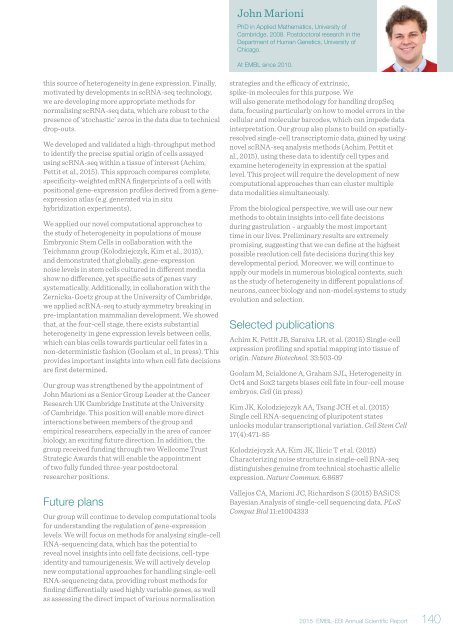Annual Scientific Report 2015
EMBL_EBI_ASR_2015_DigitalEdition
EMBL_EBI_ASR_2015_DigitalEdition
You also want an ePaper? Increase the reach of your titles
YUMPU automatically turns print PDFs into web optimized ePapers that Google loves.
John Marioni<br />
PhD in Applied Mathematics, University of<br />
Cambridge, 2008. Postdoctoral research in the<br />
Department of Human Genetics, University of<br />
Chicago.<br />
At EMBL since 2010.<br />
this source of heterogeneity in gene expression. Finally,<br />
motivated by developments in scRNA-seq technology,<br />
we are developing more appropriate methods for<br />
normalising scRNA-seq data, which are robust to the<br />
presence of ‘stochastic’ zeros in the data due to technical<br />
drop-outs.<br />
We developed and validated a high-throughput method<br />
to identify the precise spatial origin of cells assayed<br />
using scRNA-seq within a tissue of interest (Achim,<br />
Pettit et al., <strong>2015</strong>). This approach compares complete,<br />
specificity-weighted mRNA fingerprints of a cell with<br />
positional gene-expression profiles derived from a geneexpression<br />
atlas (e.g. generated via in situ<br />
hybridization experiments).<br />
We applied our novel computational approaches to<br />
the study of heterogeneity in populations of mouse<br />
Embryonic Stem Cells in collaboration with the<br />
Teichmann group (Kolodziejczyk, Kim et al., <strong>2015</strong>),<br />
and demonstrated that globally, gene-expression<br />
noise levels in stem cells cultured in different media<br />
show no difference, yet specific sets of genes vary<br />
systematically. Additionally, in collaboration with the<br />
Zernicka-Goetz group at the University of Cambridge,<br />
we applied scRNA-seq to study symmetry breaking in<br />
pre-implantation mammalian development. We showed<br />
that, at the four-cell stage, there exists substantial<br />
heterogeneity in gene expression levels between cells,<br />
which can bias cells towards particular cell fates in a<br />
non-deterministic fashion (Goolam et al., in press). This<br />
provides important insights into when cell fate decisions<br />
are first determined.<br />
Our group was strengthened by the appointment of<br />
John Marioni as a Senior Group Leader at the Cancer<br />
Research UK Cambridge Institute at the University<br />
of Cambridge. This position will enable more direct<br />
interactions between members of the group and<br />
empirical researchers, especially in the area of cancer<br />
biology, an exciting future direction. In addition, the<br />
group received funding through two Wellcome Trust<br />
Strategic Awards that will enable the appointment<br />
of two fully funded three-year postdoctoral<br />
researcher positions.<br />
Future plans<br />
Our group will continue to develop computational tools<br />
for understanding the regulation of gene-expression<br />
levels. We will focus on methods for analysing single-cell<br />
RNA-sequencing data, which has the potential to<br />
reveal novel insights into cell fate decisions, cell-type<br />
identity and tumourigenesis. We will actively develop<br />
new computational approaches for handling single-cell<br />
RNA-sequencing data, providing robust methods for<br />
finding differentially used highly variable genes, as well<br />
as assessing the direct impact of various normalisation<br />
strategies and the efficacy of extrinsic,<br />
spike-in molecules for this purpose. We<br />
will also generate methodology for handling dropSeq<br />
data, focusing particularly on how to model errors in the<br />
cellular and molecular barcodes, which can impede data<br />
interpretation. Our group also plans to build on spatiallyresolved<br />
single-cell transcriptomic data, gained by using<br />
novel scRNA-seq analysis methods (Achim, Pettit et<br />
al., <strong>2015</strong>), using these data to identify cell types and<br />
examine heterogeneity in expression at the spatial<br />
level. This project will require the development of new<br />
computational approaches than can cluster multiple<br />
data modalities simultaneously.<br />
From the biological perspective, we will use our new<br />
methods to obtain insights into cell fate decisions<br />
during gastrulation – arguably the most important<br />
time in our lives. Preliminary results are extremely<br />
promising, suggesting that we can define at the highest<br />
possible resolution cell fate decisions during this key<br />
developmental period. Moreover, we will continue to<br />
apply our models in numerous biological contexts, such<br />
as the study of heterogeneity in different populations of<br />
neurons, cancer biology and non-model systems to study<br />
evolution and selection.<br />
Selected publications<br />
Achim K, Pettit JB, Saraiva LR, et al. (<strong>2015</strong>) Single-cell<br />
expression profiling and spatial mapping into tissue of<br />
origin. Nature Biotechnol. 33:503-09<br />
Goolam M, Scialdone A, Graham SJL, Heterogeneity in<br />
Oct4 and Sox2 targets biases cell fate in four-cell mouse<br />
embryos. Cell (in press)<br />
Kim JK, Kolodziejczyk AA, Tsang JCH et al. (<strong>2015</strong>)<br />
Single cell RNA-sequencing of pluripotent states<br />
unlocks modular transcriptional variation. Cell Stem Cell<br />
17(4):471-85<br />
Kolodziejcyzk AA, Kim JK, Ilicic T et al. (<strong>2015</strong>)<br />
Characterizing noise structure in single-cell RNA-seq<br />
distinguishes genuine from technical stochastic allelic<br />
expression. Nature Commun. 6:8687<br />
Vallejos CA, Marioni JC, Richardson S (<strong>2015</strong>) BASiCS:<br />
Bayesian Analysis of single-cell sequencing data. PLoS<br />
Comput Biol 11:e1004333<br />
<strong>2015</strong> EMBL-EBI <strong>Annual</strong> <strong>Scientific</strong> <strong>Report</strong> 140


